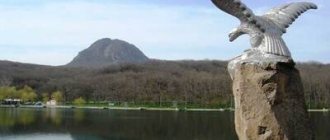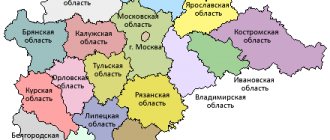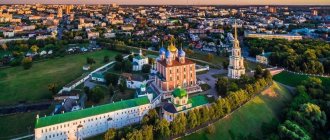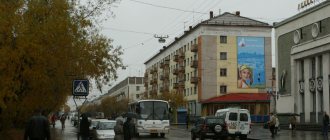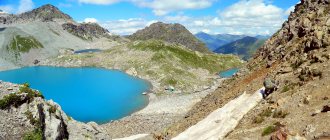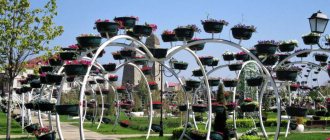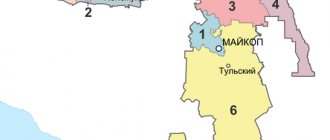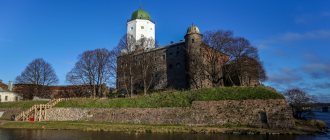The North Caucasus is the southern region of Russia with the largest population. The republics of the North Caucasus have their own rich roots, extensive history and charisma. The people of this region are distinguished by their hospitality, generosity and generosity. There are also rich musical traditions. The nature of the region is truly unique. Many come here from afar just to see this miracle. Such beauty simply takes the breath away for many tourists. The culture of this region is also interesting and diverse.
Geographical position
There are South and North Caucasus. The northern part of the Caucasus is located on the northern slope of the Greater Caucasus Range, as well as on the southern slope to the Psou River.
Extreme points:
- the northern point of this region is the village. Oktyabrsky, Stavropol Territory;
- southern point - village. Kurush (Dagestan);
- eastern point - Krainovka (Chechen Republic);
- western point - Kurdzhinovo.
This region is located in the south of the Eurasian continent; it is the largest region of the country in terms of territory. Its total area is 258 thousand square kilometers. And, of course, its population is also considerable - it is the most densely populated region.
The Caucasus was annexed to the Russian Federation at the end of the 19th century, after the end of the Caucasian War. It borders with Georgia, Abkhazia, Kalmykia, and the Krasnodar Territory. It is washed by the waters of the Caspian Sea on the eastern side.
In the north, this region borders on the Southern Federal District, which includes the Rostov, Astrakhan, Volgograd regions, etc.
Elbrus
The highest peak among the mountains of the North Caucasus. Elbrus is a cone of a frozen volcano, which is now in a state of relative peace. According to myths, it was on it that the titan Prometheus was chained to a rock because he dared to give fire to people. In the huge glaciers of Elbrus originate the sources of mountain rivers, which, joining together, flow into the Kuban - a huge river in the North Caucasus. Boiling masses still seethe in the depths of this mountain, heating springs saturated with minerals and carbon dioxide. Their temperature reaches + 52 and + 600 C.
Territorial division
Currently, the Caucasus covers two autonomous regions of Russia: Stavropol and Krasnodar and seven republics. Many are now debating whether the Foothills are included in this region. Then this concept must include both the Rostov region and Kalmykia.
Republic
Now this region includes seven republics:
- Adyghe;
- Karachay-Cherkessia;
- Kabardino-Balkarian;
- North Ossetian;
- Ingush;
- Chechen;
- Dagestan.
Each of these republics is unique, beautiful in its own way, has its own ancient history and rich traditions, which have been strictly revered since ancient times to this day.
Adygea
The capital of this subject of the Russian Federation is the city of Maykop. The republic is part of the North Caucasus economic region. It is the only one of all the republics that is located on the territory of another region (Russia).
Adygea is located on the slopes of the North Caucasus and the plains of the Kuban. Its total area is 7800 square km. The climate of the republic is temperate continental, due to its close location to the Black Sea, and the mountains contribute to increased humidity levels in this region.
Karachay-Cherkessia
This republic has been part of Russia since 1957, its capital is the city of Cherkessk. It is located in the foothills of the Caucasus, but most of it is located in mountainous areas. On the border of the republic with Kabardino-Balkaria there is the highest mountain in Europe - Elbrus.
The population of this region speaks several languages:
- Russian;
- Nogai;
- Circassian;
- Karachay;
- Abaza
Russian is considered to be the official language here. The area of the republic is 14 thousand square meters. km.
There are many mineral deposits located on the territory of Karachay-Cherkessia:
- coal;
- granite;
- marble;
- ores;
- clay.
The republic is also famous for its healing mineral waters, which attract many visitors.
Kabardino-Balkaria
The capital of this subject of the Russian Federation is Nalchik. Its total area is 12,400 square meters. km.
The population speaks the following languages:
- Kabardian;
- Balkar;
- Russian;
- Ossetian;
- Turkish
The republic is located in the central part of the North Caucasus slope. The highest point of Elbrus is located on its territory. There are also five main ridges on it.
Kabardino-Balkaria is famous for its attractions:
- waterfalls (Gedmishkh, Sultan, Abai-Su);
- lakes (Tambukan, Shadhurey, etc.);
- rivers (Terek, Baksan, Malka).
Previously, there were two regions on the territory of this republic - Balkaria and Kabarda. They united in 1922.
North Ossetia
It has a different name - Alania, the capital of the republic is Vladikavkaz. It was founded in 1924. The population speaks Russian and Ossetian languages. The total area is 8 thousand square meters. km. It is located on the plains, and Kazbek peak is also located on its territory.
The republic has rich mineral deposits:
- lead;
- copper;
- oil;
- silver
There are also sources of medicinal mineral waters here.
Ingushetia
The capital of the Ingush Republic is the city of Magas. It has an area of 3.6 thousand square meters. km. It is the smallest region of the country. The north of Ingushetia is located in the steppes, the southern part is in the mountains. The largest peak is Mount Shan.
The climate here is temperate continental. Time zone: Moscow.
The republic is famous for its attractions:
- Furtoug Falls;
- Nazranka River;
- Sunzha River;
- Assa River.
This is not the entire list of rivers; their total basin is 3 thousand square meters. kilometers.
Ingushetia has rich mineral deposits:
- oil;
- marble;
- natural gas.
Also in the republic there is a source of Borjomi mineral water.
Chechnya
In Soviet times, Ingushetia and Chechnya were united into one republic - the Chechen-Ingush Autonomous Soviet Socialist Republic. Their division into separate republics occurred in 1993.
The capital of Chechnya is the city of Grozny. The total area of the republic is 15 thousand square meters. km.
Its relief is divided into four parts:
- Terek-Sunzha Upland;
- Terek-Kuma lowland;
- mountainous part;
- plain.
The mighty Terek River flows through the middle of the republic, sung by many poets. From north to south, the plain gradually gives way to mountains. Chechnya is famous for its beauty: deep lakes, waterfalls, turbulent mountain rivers. Lake Kezenoyam is especially famous. It is located high in the mountains, has the greatest depth and the purest water. It is home to trout. The beauty of this land is truly perfect.
The population speaks Russian and Chechen. The republic is known for its war with Russia in the 90s of the last century. Then it caused enormous damage to buildings and agriculture. Work is currently underway to restore civilian facilities.
Dagestan
The capital of Dagestan is the city of Makhachkala. The total area of the republic is 50 thousand square meters. km. Previously, this territory was the Caucasus province. In 1860, the Dagestan region was formed. In 1917 it was transformed into the Mountain Republic. Then it began to be called the North Caucasus Emirate. Since 1921 it has been the Dagestan Autonomous Soviet Socialist Republic.
The population of the republic is quite diverse, as is the religion of the peoples. Dagestan is famous for its ancient fortresses and temples. There is a nature reserve on the territory of the republic. Currently, mechanical engineering is developed.
The nature of Dagestan is beautiful - mountains, lakes, rivers. The climate is temperate continental, arid in places. Relief: mountains, foothills, plains.
This republic gave the world a famous poet - Rasul Gamzatov, who glorified the beauty of his native land and the generosity of the people in his works.
History of formation
According to ancient written evidence, the first inhabitants of these places were the Cimmerians. They were engaged in cattle breeding and fought with the Scythians who entered their land. In the fourth century AD, the Huns began to invade these places. In the 7th century, Turkic-speaking Bulgars moved here. In the 8th century, the Caucasus belonged to Khazaria.
In the first millennium, four regions were formed in the Caucasus:
- Pre-Caucasian;
- Dagestan;
- Zakubansky;
- Central Caucasian.
The ancestors of the Circassians were located on the left bank of the Kuban. In the eastern part of the Kuban region there was the ancient country of Alania (the ancestor of modern North Ossetia).
From the 7th to the 10th centuries, the Arab conquests of the Caucasus took place. They spread Islam among the local population. In the 13th century, the Mongol campaigns began in the Caucasus. They completely destroyed the population of Alanya. In the 16th century, the struggle for the Caucasus began between Iran and the Ottoman Empire.
At the same time, the Russian state occupied the lands of the Caucasus. The Russian border passed through this region in the 16th century. At this time, the Terki fortress was built at the confluence of the Terek and the Sunzha. Russian Cossacks settled there and began to be called “Terek”.
In the 18th century, Ossetians and Ingush joined Russia. At the same time, our state took away the right bank of the Kuban River from Turkey. Zaporozhye Cossacks began to move there. The city of Ekaterinodar (Krasnodar) was founded.
In the same century, the Caucasian province was founded. It included six districts, its center was Ekaterinodar. Then in the 19th century the city of Armavir was founded.
After the October Revolution, the province began to be called the Mountain Republic. Two years later it split into separate areas. They became part of the USSR as autonomous republics. After the collapse of the Soviet Union, they again became independent, but are part of Russia.
Heart of Chechnya
The “Heart of Chechnya” mosque, built in Grozny in a record time of two years, is rightfully called an architectural miracle of the 21st century. It is located on an area exceeding 5,000 square meters and can simultaneously accommodate up to 20 thousand parishioners. The mosque uses painting techniques from the 16th century and was built in the Ottoman style. Snow-white marble, original dome, high minarets, amazing gold painting, 36 luxurious chandeliers with Chechen patterns. The architecture of the holy place, a luxurious park, colorful fountains - all this delights its visitors, regardless of religion or nationality. The temple amazes with its grandeur. “Heart of Chechnya” is a must see in the dark, when the entire mosque is illuminated.
Policy
The Plenipotentiary Representative of the President of Russia in the North Caucasus is Alexander Anatolyevich Matovnikov. He was the commander of the Special Operations Forces of the GRU of the General Staff of the Russian Armed Forces. He holds the rank of lieutenant general.
The foreign and domestic policy of the Caucasus remains the country's most pressing problem due to armed conflicts. For two decades now, the situation in this region has remained turbulent. Great efforts and attention are needed to resolve these issues.
The first Chechen conflict was from 1994 to 1996. After the declaration of war on Russia, Russian troops were sent into Chechnya. Contrary to expectations, it was not possible to quickly resolve the situation. The conflict dragged on for two years. Many Russian guys died. The Chechens turned into terrorists and took hostages—civilian village residents. In 1996, a truce was achieved.
But three years later, the Chechen conflict flared up with renewed vigor. The militants again began terrorist activities, and Russian troops had to be sent into Chechnya again. The bandits were driven into the mountains. The fighting ended by 2002. The following year, the Chechen Republic was formed, President Kadyrov was elected, and a constitution was adopted.
The Russian government suffered great losses, both material and moral. More than 25 thousand Russian people were killed in this war. This number exceeds losses during the Afghan war.
Until now, there are complex relations between the peoples of the Caucasus. Therefore, our government tirelessly protects state security.
The situation in the region is especially dangerous due to aggressive actions by Islamists.
Waterfalls
Tourists are presented with a stunning view: the flat plateau is suddenly interrupted, and from the top of the gorge a river falls with a terrible roar, flying near the colorful rocks. This roaring stream plays with all the colors of the rainbow in the sun.
In the mountain gorges of North Ossetia-Alania is located the Valley of Midagrabin waterfalls. Tourists are presented with a stunning spectacle - 14 waterfalls cascading down from the cliffs, rushing in streams simply from the sky. Among the peculiarities of the North Caucasus, tourists know the Greater Zaigelan, which means “falling avalanche” in the local language. This is the highest European waterfall. It carries its waters from under the overhanging glacier from a height of about 650-700 meters, and a little lower another cascade of the waterfall opens - Small Zeigelan. Due to the sharp difference in height, Greater Zeigelan is listed as one of the ten highest waterfalls in the world. In the winter, when the melting of the Midagrabin glacier stops, the waterfall transforms into ice columns that attract extreme sports enthusiasts - ice climbers.
National composition
People of different nationalities live in this region. These are representatives of different anthropological types of Caucasian races.
Representatives of the Caucasian type:
- Aguls;
- Balkars;
- Dargins;
- Ingush;
- Karachais;
- Lezgins;
- Ossetians;
- Chechens;
- Georgians;
- Kakhetians, etc.
The Pontic type includes:
- Abkhazians;
- Adyghe people;
- Kabardians;
- Circassians;
- Pontic Greeks;
- southern Russians and Ukrainians.
Representatives of the Caspian subtype:
- Kumyks;
- Azerbaijanis;
- Tsakhur;
- tatas, etc.
The Armenoid type includes:
- Assyrians;
- Armenians;
- southeastern Georgians.
In terms of population in this region, the palm is held by the Chechens, Adygs, and Abkhazians. The natural increase in the birth rate here is quite high. And mortality is reduced compared to other zones due to favorable living conditions and morality (mountain peoples do not have abortions and raise their youth strictly).
Sochi is the most beautiful city in the Western Caucasus
This urban district, although it gained tourist popularity quite a long time ago, finally earned the above title thanks to the 2014 Winter Olympics. It was she who turned an average resort, not without infrastructural problems, into a “European” center of year-round entertainment. Many are amazed by its chic transport hub, which occupies part of the Adler microdistrict, as well as Olympic and Sochi Park, which occupy the entire Imereti Lowland. At the same time, at the height of summer, utility problems have not been resolved in most of the local residential sectors, and from the early evening the southern microdistricts of Greater Sochi are always stuck in traffic jams.
Relief and climate
The relief of this beautiful region is varied. Usually, judging by its name, it is associated with the Caucasus Mountains, but on the map not all of its territory is located in mountainous areas. For example, the north of the region lies on plains called the “foothills of the Caucasus.” Gradually, to the south there is an increase in the terrain, which turns into mountains called the Greater Caucasus.
The altitude also varies from one area to another. For example, the Stavropol Territory is located at an altitude of 2.3 km above sea level, and the northern foothills are at an altitude of 600 m.
The climate in this region also varies depending on location. Mainly temperate continental prevails, but arid tropical is also found.
Flora
The nature of this region is truly unique. It is unlikely that such beauty can be found anywhere else on the planet. High mountain peaks covered with snow, fast mountain rivers, clear lakes, magnificent waterfalls. All this is due to the features of the relief. The vegetation of this region deserves special attention. The strange flowers that grow at the foot of the mountains are bright, as if painted.
Since ancient times, these places have attracted creative people: artists and poets. Pushkin and Lermontov were inspired by the local nature. They loved to visit here often, because they were inspired by the beautiful landscapes.
The Caucasus is famous for its medicinal herbs. Many useful plants grow in this area that help with various ailments.
Among them:
- Horse chestnut (helps with varicose veins, blood clots, high cholesterol).
- Lungwort (useful for pancreatitis, cholecystitis, gout, diabetes, female bleeding).
- Chernogolovka (stops bleeding, has an antimicrobial and astringent effect).
- Adam's root (useful for impotence, rheumatism, gout, osteochondrosis).
Fauna
The fauna of the Caucasus is no less diverse and unique. Rare species of individuals are found here, many of them are listed in the Red Book. Nowadays, it is increasingly rare to see animals such as bison, black stork, and Hungarian goat. There are minks in the rivers, where they hunt fish. The mountains are inhabited by roe deer, mountain goats, wild boars, and wild bears.
Religion and culture
Religion
The religious denominations of the residents are different. Most of the population professes Islam.
Among them:
- Avars;
- Adyghe people;
- Balkars;
- Ingush;
- Kabardians;
- Karachais;
- Lezgins;
- Nogais;
- Chechens;
- Circassians;
- Azerbaijanis;
- tatas, etc.
There are Orthodox Christians among the population of the Caucasus.
These include:
- Ossetians;
- Abkhazians;
- Georgians;
- Russians;
- Ukrainians.
There are also Christians of other denominations:
- Armenians;
- Assyrians;
- undines.
Among the Jews are Mountain and Georgian Jews. In this area you can find Orthodox churches next to mosques. Muslims have a normal attitude towards the presence of other religions, not counting the militant ones, which have repeatedly caused armed conflicts based on religious affiliation between the peoples of the Caucasus.
Culture
For a long time, cultural traditions have been revered in these places. Unique melodies, fire dances, peculiarities of singing songs - all this is passed on from generation to generation. Folk singing is more widespread here than anywhere else, and many have an excellent ear for music. Songs accompany all rituals in this area, from the birth of a child to funerals.
Unique wedding and folk holiday chants vary depending on location. Among the Terek Cossacks you can hear something that is not at all similar to Ossetian.
Dances of mountain peoples are a separate topic. It’s rare to find such rhythmic, unique, fiery dances. Take at least Lezginka.
The costumes of the peoples of the Caucasus are also varied. Adygs, for example, can be easily distinguished from Chechens. But all the peoples of this region share common characteristics: reverence for elders, love of tradition, respect for women, courage and self-sacrifice.
Watchtowers
The North Caucasus is one of the few places in Russia where watchtowers have been preserved - a colorful example of the original culture of the highlanders. They were located in such regions of the North Caucasus as Ossetia, Dagestan, Ingushetia, Chechnya and Kabardino-Balkaria. These fortifications had both a residential and protective function, which is why they were called guard and clan buildings. Due to enemy raids, the bulk of the construction was not preserved. Many of the towers were family ones; every family that respected its roots considered it a matter of honor to erect its own tower. According to ancient tradition, the family tower had to be built in less than a year, otherwise the family was considered dysfunctional. Such a tower was usually built near the village, in areas with good visibility. Watchtowers represent family honor, unity and fearlessness of the mountain people of the North Caucasus.
Economy
The economy of this region is directly related to exports, because this is where natural gas and oil are produced. Rare and non-ferrous metals (lead, zinc, molybdenum, tungsten, etc.) are mined in mountainous areas. The Rostov region is rich in coal. The foothills are a storehouse of metallurgical, chemical, and construction raw materials.
Mechanical engineering is also developed here. The large enterprise RosNefteGazInstrument is known. Oil and gas equipment for drilling wells is produced here.
The entire Caucasus is also called the “health resort of Russia.” People from all over the country come here to relax, recuperate and heal. Many sanatoriums are located in the mountains. Those suffering from diseases of the digestive and excretory system are treated with mineral waters. Pyatigorsk and Minvody are centers of healing springs.
The Baku-Novorossiysk oil pipeline and the Blue Stream gas pipeline connecting Turkey and Russia pass through this region. Large highways lead to Novorossiysk (M4 Don), and the M29 Caucasus highway leads to Mineralnye Vody.
This region is considered particularly fertile. The harvest is harvested several times a year due to the warm climate and favorable conditions.
Interesting Facts
In the Caucasus, the places of residence of the great Russian poets - Pushkin and Lermontov - are honored. Monuments to Pushkin stand in the places where he visited (in the city of Ordzhonikidze, Georgievsk, Pyatigorsk. It was here that he wrote his brilliant work “Prisoner of the Caucasus,” although it was originally intended to be created in Georgia. This poem was based on descriptions of the nature of the Caucasus.
Lermontov also often visited these places.
He lived :
- in Pyatigorsk;
- in Stavropol;
- in Zheleznovodsk;
- in Chechnya;
- in Dagestan;
- in Kislovodsk.
The poet loved the Caucasus very much; descriptions of the local nature can be found in many of his works (“Hero of Our Time”, “Demon”, “Mtsyri”, “Dream”, etc.) At first he was forced to visit these places for health reasons, but over time he loved the Caucasus so much that he could not live without it. how many oceans are there on earth, read our article.
Fossil elephants
A unique pair of ancient southern elephants was found in Stavropol. The entire skeleton of a fossil elephant belonging to the mammoth species is an extremely rare paleontological find. There are five similar exhibits in the world, in museums in Paris, Tbilisi, and St. Petersburg. But only in Stavropol were a couple of ancient exhibits found. These southern elephants lived 1-1.8 million years ago, the female elephant was dug up 40 years later than the elephant: she was discovered in 2007, and the elephant itself has been an exhibit of the Stavropol Museum-Reserve for decades.
